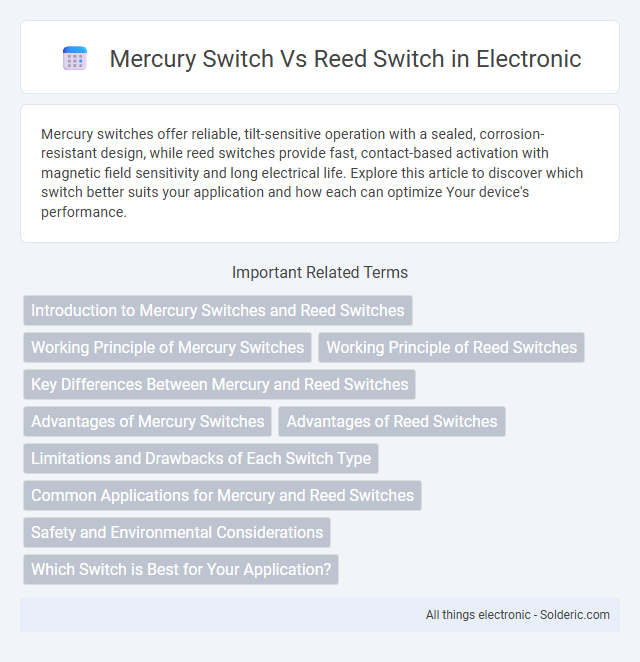Mercury switches offer reliable, tilt-sensitive operation with a sealed, corrosion-resistant design, while reed switches provide fast, contact-based activation with magnetic field sensitivity and long electrical life. Explore this article to discover which switch better suits your application and how each can optimize Your device's performance.
Comparison Table
| Feature | Mercury Switch | Reed Switch |
|---|---|---|
| Operating Principle | Uses liquid mercury to open/close the circuit based on tilt | Magnetic reeds close/open contacts when exposed to magnetic field |
| Contact Type | Normally open or normally closed mercury contact | Normally open or normally closed magnetic reed contacts |
| Durability | Fragile due to mercury content and glass casing | Robust and sealed in glass, less prone to damage |
| Environmental Impact | Toxic mercury, environmental hazard | Environmentally safe, no toxic materials |
| Switching Speed | Slow response time due to liquid mercury movement | Fast switching response to magnetic field changes |
| Applications | Level sensors, tilt sensors, thermostats (older use) | Proximity sensors, security systems, relays, reed relays |
| Size and Weight | Relatively heavier and bulkier | Lightweight, compact |
| Maintenance | Often requires careful handling and disposal | Low maintenance, reliable over long life |
Introduction to Mercury Switches and Reed Switches
Mercury switches contain a small amount of liquid mercury that completes an electrical circuit when tilted, providing reliable and vibration-resistant performance. Reed switches consist of two ferromagnetic blades enclosed in a glass capsule that close or open when exposed to a magnetic field, offering precise switching action in compact designs. Understanding the fundamental differences between mercury and reed switches helps you select the best option for your specific application needs.
Working Principle of Mercury Switches
Mercury switches operate based on the movement of a small amount of liquid mercury inside a sealed glass or metal container, which acts as a conductive element to complete or break an electrical circuit when tilted. The mercury flows to connect or disconnect electrodes depending on the switch's position, providing reliable on/off switching with minimal mechanical wear. This liquid metal mechanism offers smooth operation, vibration resistance, and long lifespan in applications requiring tilt or tilt-angle sensing.
Working Principle of Reed Switches
Reed switches operate based on the magnetic attraction between two ferromagnetic blades sealed within a glass envelope, which close or open the electrical circuit when exposed to an external magnetic field. The contact blades flex and come together under the influence of the magnetic field, enabling a low-voltage, low-current signal to be transmitted. This non-contact actuation mechanism makes reed switches highly reliable for precise switching in security systems, automotive sensors, and telecommunications.
Key Differences Between Mercury and Reed Switches
Mercury switches use a small amount of liquid mercury to complete an electrical circuit when tilted, providing reliable conductivity and resistance to vibration. Reed switches rely on magnetic fields to move flexible metal reeds inside a glass envelope to open or close a circuit, offering high sensitivity and fast switching speeds. Key differences include mercury switches' robustness in harsh environments and tilt-based operation versus reed switches' suitability for magnetic field sensing and lower power consumption.
Advantages of Mercury Switches
Mercury switches offer exceptional reliability due to their sealed, liquid metal contact that resists oxidation and wear, ensuring long operational life and consistent electrical performance. They provide precise, low-resistance switching with minimal contact bounce, making them ideal for sensitive or low-current applications. Their tolerance to harsh environmental conditions, including vibration and shock, further enhances their durability compared to reed switches.
Advantages of Reed Switches
Reed switches offer significant advantages over mercury switches, including enhanced environmental safety due to the absence of toxic mercury, making them a preferred choice for eco-friendly applications. They provide faster response times and greater longevity because their sealed contacts are less susceptible to corrosion and wear. Your designs benefit from their low power consumption and compatibility with a wide range of voltages, ensuring reliability and efficiency in various electronic and industrial uses.
Limitations and Drawbacks of Each Switch Type
Mercury switches have limitations including environmental hazards due to toxic mercury content and fragility in extreme temperatures, which restrict their use in eco-sensitive and high-temperature applications. Reed switches, while more environmentally friendly, suffer from limited current capacity and susceptibility to contact wear and arcing over time, impacting reliability in high-load circuits. Both switch types require careful consideration of application-specific conditions to mitigate their respective drawbacks effectively.
Common Applications for Mercury and Reed Switches
Mercury switches are commonly used in tilt sensors, thermostats, and safety devices due to their reliable liquid metal contact that ensures smooth and stable operation in harsh environments. Reed switches find extensive application in security systems, proximity sensors, and automotive controls because of their low power consumption and fast switching capabilities. Both switches play crucial roles in industrial automation, consumer electronics, and instrumentation where precise and durable switching mechanisms are required.
Safety and Environmental Considerations
Mercury switches contain toxic mercury, posing significant environmental hazards if broken or improperly disposed of, which can lead to soil and water contamination. Reed switches are safer alternatives, using inert gases and sealed contacts that eliminate the risk of mercury exposure and environmental damage. Choosing a reed switch enhances your safety protocols and aligns with eco-friendly practices.
Which Switch is Best for Your Application?
Mercury switches offer reliable, tilt-activated operation with a sealed liquid mercury contact, making them ideal for harsh environments requiring durability and precise actuation. Reed switches use magnetic fields to open or close contacts without physical contact, providing low power consumption and long life for sensitive or remote sensing applications. Your choice depends on factors like environmental conditions, response sensitivity, and safety requirements, with mercury switches excelling in stability and reed switches favored for low maintenance and minimal power use.
mercury switch vs reed switch Infographic

 solderic.com
solderic.com